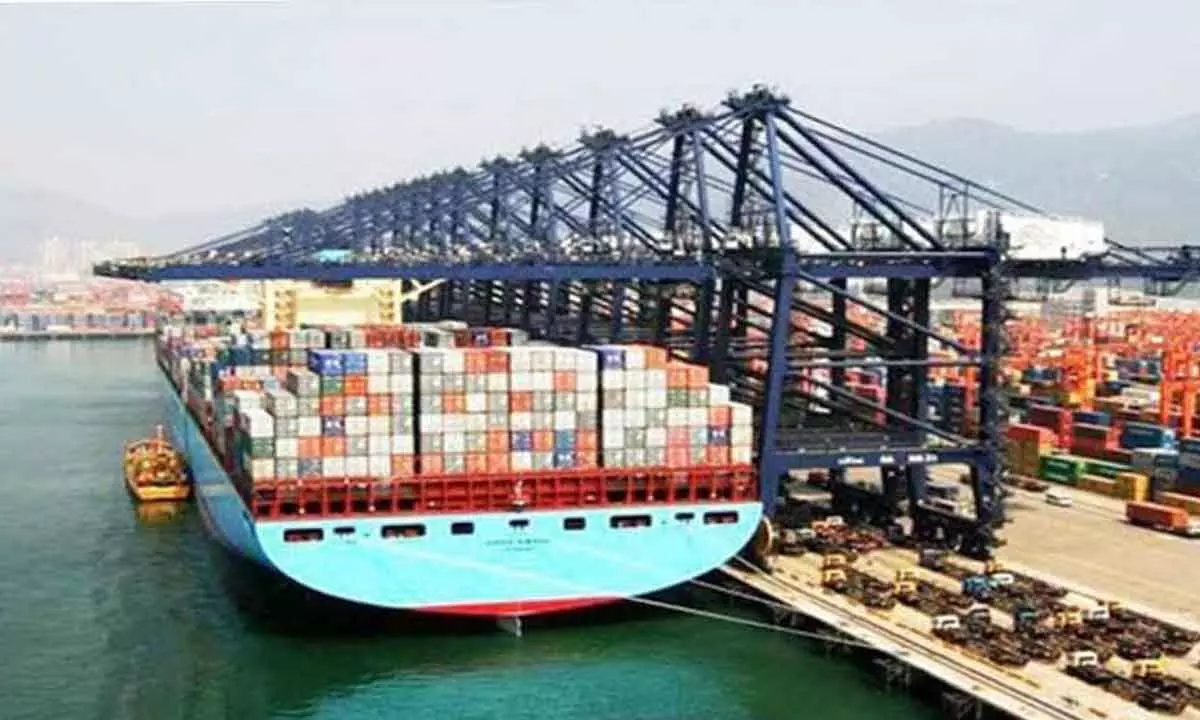India's merchandise exports cross $400-bn milestone in FY22
Emergence of new trade corridor through FTAs/ECTA/CEPA, PLI scheme among others have contributed to this growth, says an internal economic research report by SBI
image for illustrative purpose

Mumbai: India's merchandise exports touched a record $420 billion in FY22. It took the country a decade to incrementally add another $100 billion ($300 billion mark was touched in FY12) as against reaching $200 billion from $100 billion in only 5 years (FY06 to FY11).
Emergence of new trade corridor through FTAs/ECTA/CEPA, PLI scheme among others have contributed to this growth, says an internal economic research report by SBI. India's exports of goods and services (per cent of GDP) which was only 3.7 per cent in 1970 and 6.1 per cent in 1980, reached a peak in 2013 (25.4 per cent) but decelerated thereafter till 2020 (18.7 per cent) mirroring the global trend. The share of service exports in total exports has increased gradually, and significantly from 27 per cent in FY2001 to 41 per cent in FY21, though moderating to 37 per cent in FY22.
Interestingly, the concentration of top 10 countries in our export basket has reduced over the years and share of others have increased, thereby implying diversification of export destinations! Top 15 exports accounted for more than 72 per cent in our total export kitty during Apr-February.
"Contrary to popular perception, our estimates show that 55 per cent of the increase in exports in FY22 is attributed to quantity effect and the rest 45 per cent is the price effect, indicating that the growth in exports in FY22 could be sustained if we continue to follow right policies," says Soumya Kanti Ghosh, SBI group's chief economic advisor.
As expected, our results show that only 31 per cent of the increase in exports of petroleum crude and products in FY22 can be attributed to higher quantity and rest 69 per cent is because of higher price.
In the case of imports, 26 per cent is quantity effect and the rest 74 per cent is the price effect, which is obvious given the elevated level of global commodity/food prices India's agricultural exports rose remarkably despite Covid-19 and crossed the $50 Billion mark in FY22. However, the large gap in MSP and global prices is likely to incentivise export of wheat from India. This needs to be judiciously balanced with domestic supply of wheat, he added India is following a policy of import rationalisation with China. India imported $5 billion less from China in FY20 vis-a-vis FY19 and further $48 million lower in FY21. However, in FY22 our imports from China increased significantly, reflecting the pandemic induced uncertainties. The share of imports from China has however declined in FY22. Simultaneously, India has been also able to push exports to China and in FY22 it occupies a share of 5.2 per cent of our exports/3rd in terms of ranking of countries.
India's service exports of Telecommunications, Computer, and Information Services far outpace China. However, China is rapidly catching up and India needs to buckle up in these areas.
India has revealed comparative advantage in certain goods where China doesn't have. This include select chemicals, minerals, stone and glass, animal and vegetable. India needs to protect such products in which it has a Revealed Comparative Advantage over China. This will provide support to MSMEs.
India is pushing for fresh FTAs and trade concessions with major economies and regional blocs in a bid to boost export-oriented domestic manufacturing as it chases an ambitious export target of $450-500 billion in FY23.
The prime objective of an FTP is to facilitate trade by reducing transaction cost and time. It aims to work with state governments to implement 'District Export Hubs' that will work towards achieving the export goals of each state.
India recorded a CAD of 1.2 per cent of GDP in Apr-Dec 2021. FY23 will be a challenging year since as per the report, CAD will breach the 2.5 per cent mark and may reach to a decade's high.
The rupee has remained remarkably stable in the current scenario, thanks to RBI exchange rate policy that has been nicely dovetailed into inflation targeting. Indian regulators and policy makers, and bodies like FEDAI must now use this opportunity to seek equal, and appropriate footing for INR in the changing realms lest we lag behind in a crucial/critical area.
Services and manufacturing, the study goes on, have to be viewed as complementary and not as exclusive activities. A realignment of India's export strategy that views services as an integral part of manufacturing and structures the regulatory and trade policies consonant with this view, will provide multiple benefits of enhanced productivity, manufacturing competitiveness, export and employment potential, all of which are essential inputs for a strong post-pandemic recovery.

